I would imagine Spock Prime would start with preserving Vulcan culture first.
-
Welcome! The TrekBBS is the number one place to chat about Star Trek with like-minded fans.
If you are not already a member then please register an account and join in the discussion!
You are using an out of date browser. It may not display this or other websites correctly.
You should upgrade or use an alternative browser.
You should upgrade or use an alternative browser.
Kelvinverse theories and head canon
- Thread starter Laura Cynthia Chambers
- Start date
- Status
- Not open for further replies.
That's why it's important to spread knowledge, animals, plants, and artifacts around. If something happens to a world or facility, all is not lost.
Since Vulcans have off world colonies some would be.That's why it's important to spread knowledge, animals, plants, and artifacts around. If something happens to a world or facility, all is not lost.
And the rebuilding process will be complicated; melding the pre-existing ecosystems on New Vulcan with the needs of old Vulcan's creatures.
Ads are making the site illegible.
Red matter is number 10 and their biggest question is how to deploy it? Ok, I think I'm good.
Red matter is number 10 and their biggest question is how to deploy it? Ok, I think I'm good.
Wow this is a blast from the past. Feels like it's been forever since I've since this kind of cinemasins listicle.
On the plus side: We know what Maurice is up to.
On the other hand: It's a
 ing slideshow, and I'm disinclined on principle to go through nine other pages to see what makes up the rest of the list.
ing slideshow, and I'm disinclined on principle to go through nine other pages to see what makes up the rest of the list.(Didn't Buzzfeed at least manage to do these all on the same page? Seriously, there's only one reason to do a listicle as a slideshow, and that's to force you to look at [number of pages]X the ad content.)
Yeah. It's frustrating to navigate and I don't see it being worth the scroll.On the other hand: It's aing slideshow, and I'm disinclined on principle to go through nine other pages to see what makes up the rest of the list.
Yeah, I'm a little surprised to see anyone still using that trick (except maybe Rolling Stone, and they only do it to break their 500-place lists up into more readable groups of 50 per page.) Almost everyone else gave up on slideshows years ago, because no one will read them anymore.Yeah. It's frustrating to navigate and I don't see it being worth the scroll.
[SIZE=6 said:10 Dumbest Things In Star Trek (2009)[/SIZE]
]
Despite being sold as an action-adventure show, Star Trek’s always had something of a rep for putting story before action, so much so that it’s often and accurately characterized as “talky.” Even as video compositing and CGI saw the cost of visual effects drop, the Trek franchise largely avoided the influence of Star Wars to go big on the action at a cost to character and theme.
That changed when director JJ Abrams rebooted the original as a big-budget blockbuster in 2009 and dialed the action-adventure quotient to Lucasfilm levels. The reaction? Well, no one can hate on a franchise like its own devotees, and many were the fans that decried this new take in a Not My Star Trek fashion and accused it of dumbing down their favorite sci-fi enterprise.
Sure, there's plenty that's silly, convenient, and coincidental. And some will never forgive the lens flares or the brewery. But those nitpicks aside, what's truly dumb in the Kelvin timeline?
Let’s implode some red matter and make a portal back to 2009 and find out.
10. Red Matter Matters
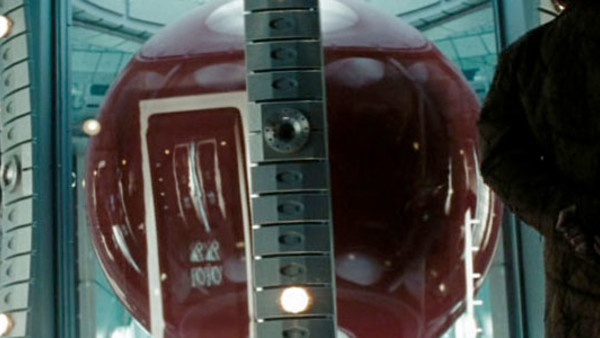
Paramount Pictures
Despite fan complaints, the so-called Red Matter is no more preposterous than a lot of other unobtainium substances postulated and employed in various Treks, be it star-killing trilithium (Star Trek Generations) or the anything-muppet Genesis Wave (Star Trek II and III), to name but two examples. If we’re being honest it’s the dumb name that fans bristle at. If it had been called “quantum-gravitic xyrillium” or some other technobabble words pulled out of someone’s aft, no one would have blinked. But calling it “Red Matter”...somehow that was the bridge too far.
Silly name aside, if the Red Matter can form a black hole capable of Hoovering up a supernova, just how is it supposed to be deployed? Some supernovae leave nothing where the star was, and others leave various types of collapsed stars at their centers. Can Spock Prime set it off in the hollow center of where the star had been? How the hell do you drill into a neutron star? If before the star blows up, was he supposed to get it into the star’s core? If not, why did the Nero have to drill to the center of Vulcan and the Earth to set it off?
Did anyone even think this through?
I think we know the answer to that…
9. Numbskull Nero
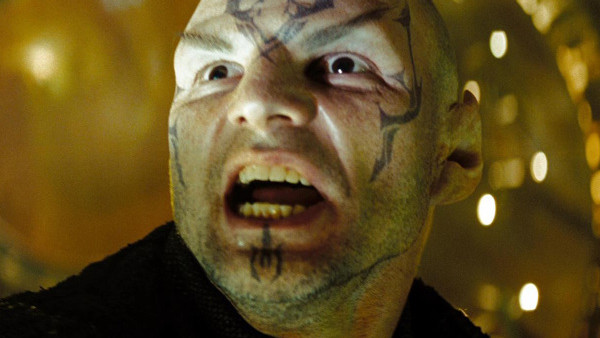
Paramount Pictures
Eric Bana’s performance as nutball Nero transcends the paper-thin character seen on screen. One can rationalize any idiocy of Nero’s on the fact he’s not operating on all thrusters on account of his grief. Indeed, unused bits from the shooting script make plain this is the case, but not enough of this is in the finished film for it to land.
Even accepting that Nero is determined to nuke the Federation for failing to save his home planet and family in the fuuuuuture, being that he’s now in the past before this tragedy he really ought to make a beeline for home and use Prime Spock’s Red Matter to prevent the supernova that threatens Romulus… because why even take the risk that his ship might be stopped or damaged whilst imploding Federation planets? There’d be plenty of time for vaguely motivated genocide afterward.
What’s especially stupid is that he spares the Enterprise so young Spock can watch Vulcan die, but he could just as well have insisted Spock come over with Pike and let him watch the planet’s destruction from there…or just jump him on Delta Vega with Spock Prime and let them deal with that on top of their misery. Either way, he should have nuked the Enterprise, as it’s the only thing that could warn Starfleet about him.
But, nah, not only is Nero nuts, but he’s dumb as a box of rocks.
8. A Simple Mining Vessel
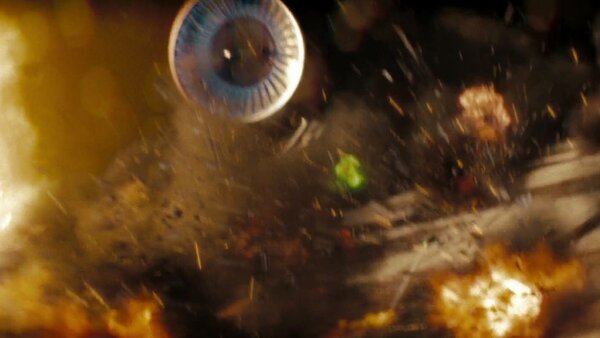
Paramount Pictures
It’s not unbelievable that the Narada’s future tech makes it nearly invincible to the weapons of a century earlier. I mean, imagine the cannons of an early 19th-century warship trying to punch through the steel hulls of a 20th-century seagoing ship.
But the truly dumb thing is its firepower. The Narada reportedly destroyed 47 Klingon warbirds in a single go. Note that we witness at least six fragmenting torpedoes hit the Kelvin and it doesn’t completely come apart. One assumes decades-newer ships like the task force with the Enterprise must be at least as tough. So how many such torpedo hits does it require to take down 47 warbirds and five starships? 300? 400?
The point: Nero says "In my time, where I come from, this is a simple mining vessel." So why the hell does it possess such incredible firepower (tie-ins aside) and the tactical systems to use it? Is space piracy so bad in 24th-century Romulan space that miners require such weapons?
Perhaps this would have been believable if the fragmenting torpedoes were identified as asteroid-shredding mining tools that Nero employs as weapons against his comparatively antiquated foes … except that these torpedoes go through starship shields as if they weren’t there, which suggests they’re weapon-weapons.
Why is a simple mining vessel armed to the teeth?
Because it’s a summer blockbuster.
Pew pew! Dumb dumb!
7. Starships Annihilated In Seconds
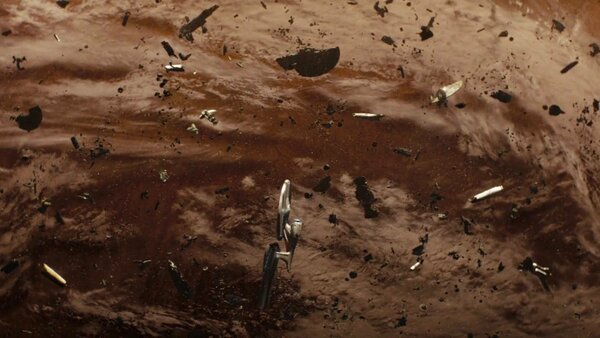
Paramount Pictures
Given that the Narada is demonstrated to have inexplicable weapons, there's still the question of rate-of-fire. How believable is it that it’s capable of targeting and annihilating multiple starships in literally seconds? Because that’s what happens. At least four starships are seen warping off more or less simultaneously for Vulcan (the script says five) while the Enterprise, lagged because new helmsman Sulu forgot to release the parking brake. It takes less than a minute for this hiccup to be resolved, and the hero ship is off like a shot.
This brand-new Enterprise is described as being the “flagship” (that Star Trek doesn’t grok what constitutes a flagship is a gripe for another article), so it’s unlikely to be significantly slower than the rest of the task force. As such, she’s at best a minute or so behind her sister ships, yet she arrives over Vulcan amidst the wreckage of them. So how is this possible? Did Nero manage to open fire the instant those ships came out of warp?
When Nero goes all "fire everything!" at the film's climax, the Narada launches a total of 25 torpedoes, then stops, which suggests this is the most it can fire without reloading. Maybe that's enough to shred a task force of five starships in a minute, but what about those aforementioned 47 warbirds? Or did the Klingons just hang around while Narada reloaded, despite seeing their weapons were useless?
6. Safety Last
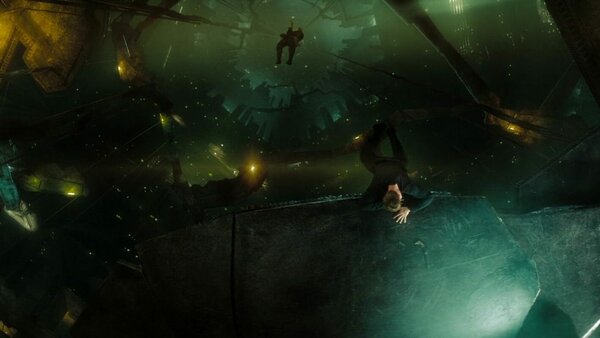
Paramount Pictures
What is it with action adventure movies and bottomless pits? In the old days a cliché danger was quicksand. Nowadays it's gigantic plunges into the abyss. Past cinematics Treks guilty of this were Star Trek III and Kruge's drop on the Genesis Planet, and Nemesis with its inexplicable high-dive from the lowermost decks of the Enterprise-E.
But those are nothing compared to the ultra-unsafe workplace that is the Narada, the interior of which takes its safety cues from that galaxy far far away in Star Wars, where the only guardrail seems to be the Force. The Narada's guts are a nightmare of pointy hazards, wet surfaces, pointlessly staggered walkways, and "watch your step" drops, with nary a guardrail to be seen.
One must assume there’s no Romulan Equivalent of the HSE or OSHA (Health and Safety Executive in Britain, Occupational Safety and Health Administration in the US). I guess Romulans and their martial “if we are the stronger” mentality must figure it weeds out weaklings. Darwin Awards to everyone not as nimble as a mountain goat.
5. Burning To The Center Of The Earth
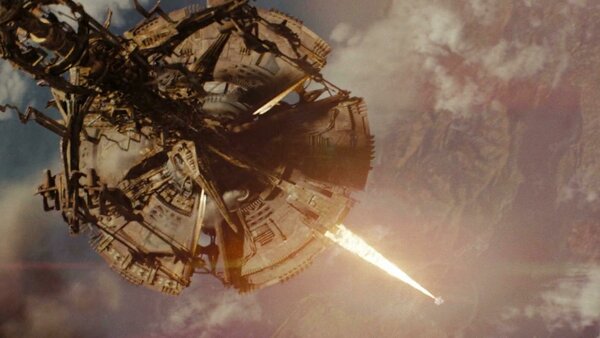
Paramount Pictures
With apologies to Jules Verne, who penned his Voyages extraordinaire long before we had technologies to peek through solid rock and glean an understanding of the Earth’s guts, the Narada’s drilling platform makes no sense. Why the need to lower it down into the breathable atmosphere? Does anyone realize how far that is from even low orbit? Is the Narada's ginormous size simply so that it can hold the preposterous cable necessary to bridge such a distance?
That aside, you can’t drill a stable hole to the center because the Earth isn’t made of solid rock, as any active volcano demonstrates. Hell even familiar materials behave differently under the intense pressures found deep inside a planet like Earth. Molten iron-nickel, anyone? That hole is going to constantly cave in and fill any gap made by fricking lasers or phasers or whatever this silly drill beam is. This pressure problem would exist on Vulcan as well, even if it’s older and cold to its core.
The only way this works is if — in addition to its flaming drill beam — the Narada is constantly projecting an immensely powerful cylindrical forcefield down the thousands of kilometers deep hole to hold it open and allow the Red Matter to hit bottom. But since the hole remains gaping even after Kirk and Sulu decommission the drill, this clearly ain’t the case.
4. Moronic Marooning
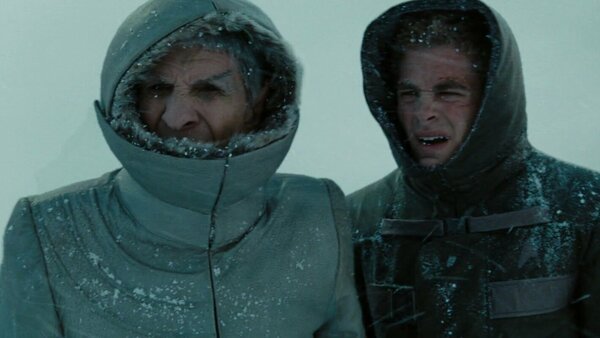
Paramount Pictures
Nothing about or that happens on Delta Vega makes sense. It's habitable but apparently uninhabited, despite being within Mark I eyeball viewing distance of Vulcan. There's a Starfleet outpost there, but the communications-damaged Enterprise doesn't pull up and try calling via communicators to determine if the outpost has any capability to contact, well, anyone who could get a warning to Starfleet. Kirk's marooned to the outpost via a pod that can't land anywhere near it. Kirk has a communicator but is never shown trying to call for assistance. And Scotty and Keenser both are clueless that the planet next door has vanished.
Just why doesn't the outpost have subspace radio? Or did it get its phone service from formerly nearby Vulcan? Guess it's time to switch carriers.
And did Nero drop Prime Spock within walking distance of the outpost so he could live with the memory of Vulcan's destruction rather than freezing to death or being eaten by the local fauna, as Kirk nearly was? And how on Hoth did Spock get that wooden torch?
Finally, is Lt. Spock, a pirate captain? Marooning was usually punishment for mutineers, and effectively a death sentence. Back in the OG series, Kirk marooned Gary Mitchell because Mitchell was a growing and uncontrollable threat to the ship and there was no way to contain him. But cadet Kirk? Spock hangs a lantern on his decision to maroon Kirk by saying he would probably escape a brig cell. So, how about sending someone to the surface via shuttlecraft with Kirk in tow while the Enterprise warps away?
Delta Vega is the delta of dumb.
3. The Bogus Supernova
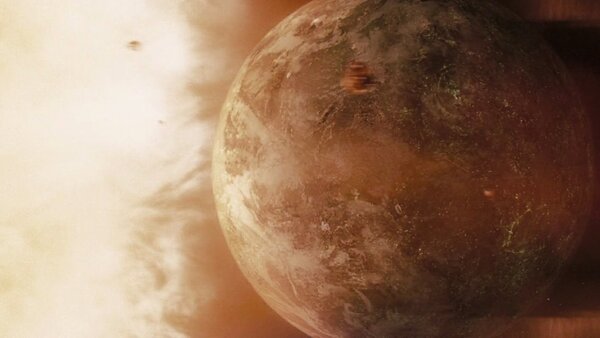
Paramount Pictures
First things first. Many websites and wikis describe the star that destroyed Romulus as the “Hobus Supernova,” but that stems from a four-issue comic book tie-in titled "Countdown," and is neither in the shooting script nor the finished film. In short: Hobus is bogus.
All Spock Prime tells Kirk is that in the future “a star will explode, and threaten to destroy the galaxy.”
Yeah … about that…
Supernovae are a big deal — emphasis on B I G — but even the biggest supergiant stars only have so much mass and energy to throw around when they go kaboom, all of which becomes more diffuse the farther it gets from the source. Such an explosion could affect planets within a few hundred light years at most, many years or centuries later, since what a supernova flings out is limited by the speed of light. And, since our galaxy is estimated to be 100 thousand light-years across, no way, no how, does a single supernova threaten the entirety. Even if this event threatened the civilizations of the known galaxy, precision-minded Spock Prime would never characterize it as a threat to the galaxy: he’d calculate the number of endangered worlds to three decimal places. Hyperbole is illogical... and dumb.
Anyway, while Spock Prime used the "Red Matter" to successfully create a black hole to Hoover up the supernova, the reality is you can't put smoke back in a bottle. Even a black hole can't claw back the radiation released, which has zoomed off at light speed and ain't making a U-turn. No undo there.
The movie doesn't identify the star that went supernova as Romulus' sun (Star Trek Picard did, but that's another matter), but it seems likely given the visuals. If so, then the only way Spock could have saved the planet is to Red Matter the star before it could 'splode and cook Romulus with radiation. That would leave the planet with no sun and no heat, but time to rescue the population, assuming the Romulans have lots of power to stay warm, keep the lights on, and sufficient food in reserves or being delivered.
(Math fun! A fleet of a thousand ships, each one capable of moving ten thousand people per trip, and each round trip taking one week, would require 11 and half years to evacuate six billion people.)
2. Hitting A Bullet With A Smaller Bullet
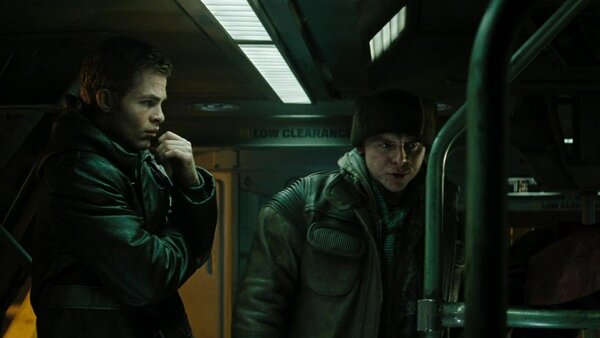
Paramount Pictures
Transporters have always been magic passed off as science so the concept of transwarp beaming is really no more preposterous than beaming at all. What’s dumb about the transwarp beaming in this movie is exactly what Scotty describes but Spock waves away: trying to hit a bullet with a smaller bullet whilst wearing a blindfold, riding a horse.
Consider that they’re aiming at a moving target that they have zilch data about, other than where it’s heading (the Laurentian system), and the warp three velocity Spock ordered before throwing Kirk overboard. There’s zero indication they know exactly when the Enterprise went to warp, whether it has changed velocity, or if young Spock changed his mind about his destination. If the Delta Vega outpost sensors could detect the ship in warp then you might buy it, but Swiss Army Knife Spock Prime just pulls some numbers out of his Vulcan arse and it works.
Can this get any dumber? Of course it can! If you have transwarp beaming, why send Kirk and Scotty to the Enterprise instead of to another Federation member planet or right to Starfleet Command ahead of the Narada’s arrival? Or, hey, send Kirk to the Enterprise and Scotty to Starfleet Command, thus covering both bases!
The real-world reason is to contrive to get the OG crew all on the Enterprise, and that’d be all fine and good if the script did it in a way that was sensible … not stupid.
1. Captaining Kirk
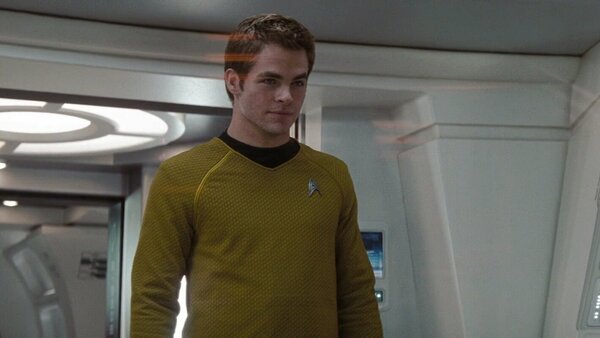
Paramount Pictures
The role of the ship’s captain confuses a lot of people on Trek and in fandom who don’t all realize that “captain” can mean two things: it’s a rank — like commander or admiral — and it separately refers to the job being the commanding officer on a ship. This is why McCoy could accurately say Commander Spock was the captain in “The Tholian Web,” because Kirk had been declared dead. Spock doesn’t have to hold the rank of captain to be THE captain of the ship.
But that doesn’t mean just anyone can command a ship (emergency situations aside). Being the captain requires knowing everything about how the ship works, and there’s no way even a Brainiac Kirk who can whiz through Starfleet Academy in three years is going to have both the knowledge and practical experience to command a top-of-the-line state-of-the-art starship, no matter that he’s the hero. Starfleet might leave him in provisional command for PR purposes, wait for the public eye to shift, then shuffle him off to a less prestigious command to really earn his stripes.
But the movie is bound and determined to leave Kirk in that chair by the closing credits, no matter how nonsensical that decision is.
Thanks for saving everyone time by putting that together.[ 10 dumbest things copy / pasted as a single list ]

I can't help feeling, though, like it's a retread of all the mostly-interchangeable "10 Things I Didn't Like" critiques many of us remember reading 15 years ago, when this was still the most recent Star Trek film. Or of the repeated Peevish Checklist Recitations by a certain poster who shall here remain nameless.
There just wasn't anything new to be gleaned from it.
Yup.Thanks for saving everyone time by putting that together.
I can't help feeling, though, like it's a retread of all the mostly-interchangeable "10 Things I Didn't Like" critiques many of us remember reading 15 years ago, when this was still the most recent Star Trek film. Or of the repeated Peevish Checklist Recitations by a certain poster who shall here remain nameless.
There just wasn't anything new to be gleaned from it.
Very unoriginal.
Other Trek movie listicles on the site list 14 dumbest things compared to 10 for this one, therefore I can only assume that Star Trek (2009) is less dumb than Wrath of Khan.
https://www.giantfreakinrobot.com/ent/star-trek-sinto-darkness-brilliant.html
After the runaway success of Star Trek (2009), many fans and critics felt the sequel film Star Trek Into Darkness was a disappointment and the general consensus was that the whole thing felt like a less impressive version of The Wrath of Khan. Now, we’ll grant you that bringing Khan back was a terrible decision that led directly to a lackluster third act. However, if you can look past the flaws glaring as brightly as J.J. Abrams’ lens flares, you’ll discover that Star Trek Into Darkness is secretly one of the most brilliant films in the franchise.
Kirk’s Career
One of the things I love best about Star Trek Into Darkness is that it almost immediately addresses the insane ending of the previous film. In Star Trek (2009), after Kirk and his fellow Starfleet Academy cadets save Earth from the Romulan Nero, they all get to bypass the rest of their academy training and jump right into working on one of Starfleet’s most advanced ships. Kirk himself, after entering the academy late and generally being a womanizing rule-breaker, is suddenly catapulted into command of the Enterprise.
Giving someone so much power at a young age is a terrible idea, and Star Trek Into Darkness proves this by having Kirk immediately violate the Prime Directive, causing Starfleet to take away his captaincy. Drama with Khan almost immediately gets Kirk out of trouble and back out into the field, but I still enjoyed the movie going out of its way to showcase that Kirk still had a lot of growing up to do. He wasn’t really captain material by the end of the first film, and this sequel highlights how he had to literally die for the crew before gaining some much-needed maturity.
Star Trek Self Correction
The very fact that the absurdity of Kirk’s instant promotion is addressed in Star Trek Into Darkness, makes it unique in at least one way: it proves to be a Star Trek film that pokes fun at its own ideas while also giving the main character some much-needed character growth. We’ll take that over another grimdark episode of NuTrek featuring perfect, static characters any day of the week.
Section 31
Even though the secretive organization is set to get its own Star Trek movie very soon, Section 31 remains one of the most controversial ideas in franchise history. The notion that Starfleet has a hidden division that handles dirty tricks and wetwork has never sat well with many fans specifically because it is so contrary to the philosophy and ethos of Trek. With that being said, Star Trek Into Darkness is one of the few times that Section 31 is used very well.
We get the requisite evil admiral (played by RoboCop himself, Peter Weller) who has exploited Khan’s genius to develop a powerful Starfleet Dreadnaught-class ship. It’s easy to be dismissive of the movie giving us yet another bad guy with another huge ship, but it actually makes plenty of narrative sense that Section 31 would now be working so brazenly. The inciting incident of the Kelvinverse was an impossibly powerful Romulan ship destroying a Starfleet vessel, so it figures that Section 31 would have spent the intervening decades trying to build bigger and badder weapons.
Reflecting The Real World
The idea that Section 31 could now operate more openly than we saw on Deep Space Nine points to characters like Admiral Marcus seizing power after Starfleet barely survived Nero’s attack. That grounds Star Trek Into Darkness with a crunchy metaphor about how national governments around the world always use national defense as a pretext for taking the most inhumane of actions.
Kirk And Spock
Another thing fans like to dunk on Star Trek Into Darkness about is how it inverts the climax of The Wrath of Khan. Kirk dies sacrificing himself rather than Spock, leaving the now angry Vulcan to retrieve some blood from Khan–blood, conveniently enough, that is able to bring Kirk back to life. I’ll grant you that this entire plot is deeply disappointing, but here’s the thing: underneath that goofy climax is a solid understanding of Kirk and Spock’s friendship, and that understanding helps the movie shine.
An inherent problem of Star Trek (2009) is that it accelerated all character relationships, thrusting Kirk and Spock into a reluctant partnership rather than giving their friendship years to develop. They don’t always connect, but Into Darkness takes its biggest swings when it shows Kirk trying to explain the importance of their growing friendship to Spock, a character who doesn’t truly understand all of this until Kirk is dead. In that way, this often-overlooked sequel gives us some of the best Kirk and Spock character development the franchise has ever seen, and the performances from Chris Pine and Zachary Quinto really sell this as a legendary friendship.
There are plenty of better Star Trek films, including the one that came immediately after this one. However, no other film quite emphasizes how Kirk and Spock are the heart and soul of the Enterprise, and that’s just one more reason this sequel is secretly brilliant.
10 Dumbest Things In Star Trek Into Darkness
Is JJ Abrams’ sequel to his 2009 Star Trek controversial? You Khan bet your magic blood on it!
BY MAURICE MOLYNEAUX
JANUARY 31ST, 2024
Star Trek Into Darkness, released in 2013, generated significant anticipation among fans and the general audience alike. Following the box office and critical success of the 2009 reboot directed by J.J. Abrams, expectations were high for the sequel. The first film had not only introduced the classic Star Trek characters to a new generation but had also revitalized interest in the franchise, making the prospect of a follow-up particularly exciting. The return of the main cast, including Chris Pine as Captain Kirk and Zachary Quinto as Spock, played a significant role in building anticipation. The chemistry and performances of the ensemble cast in the first film had been well-received, and audiences were eager to see them in the sequel.
One factor contributing to the anticipation was the mystery surrounding the film's plot. Speculation ran rampant that the film's antagonist would be Khan Noonien Singh, best known for the fan- and critic-favorite, Star Trek II: The Wrath of Khan. This was vociferously denied, but few were surprised when nominal villain John Harrison (Benedict Cumberbatch) was revealed to be Khan.
The film received many good reviews but mixed audience response. For every excellent choice, there was an inexplicable one. The resulting film was, by turns, smart and stupid. Here are 10 truly dumb things in it.
10. Kirk's Prime Directive Violation
The film’s opening is fun and plays like an OTT spoof of an original series “running and jumping” action sequence. It puts a spotlight on five of the seven leads, is dynamic and exciting, but it’s as smart as a bag of bricks. And that’s not referring to the starship playing Yellow Submarine (we’ll get to that).
First, why are they doing this in broad daylight? Did they happen to find the volcano and the threatened natives just before the imminent cataclysm? Or does this planet have really long days that prevents waiting til night to pull this stunt when the ship would be perhaps less visible? Or maybe the natives’ night vision is that good?
Second, what was Kirk leading the natives on a merry chase supposed to accomplish? Was he deliberately luring them as far as possible from the volcano because he saw the script called for their temple/whatever to be obliterated by raining magma before Spock could drop his “super ice cube”? Must be, because otherwise keeping the locals indoors would better prevent them from seeing the shuttle or potentially the Enterprise.
Finally, how did Kirk not know about the riding animal Bones had rounded up? Wasn’t that part of the plan? Or was Bones showing some initiative and Kirk boofed it?
And speaking of the ship’s doctor, just what is he doing here? Granted, on the OG he was often on landing parties for no good reason, but is the chief surgeon the best man to help lure an angry mob to a cliff?
9. War, What Is It Good For?
Admiral Robocop… er, Marcus’ plan is a mess. On one hand, he says all-out war with the Klingons is inevitable, so he dreams of a militarized Starfleet with which to pre-emptively start and end the conflict. But… how, exactly?
Okay, sure, he had Khan develop new long-range and (supposedly untraceable) photon torpedoes, and he’s got the big bad starship Vengeance (a stupid name; who is he getting vengeance on?). But think about it, as super-duper powerful as that one black ops black starship is, it’s one ship. It can’t be everywhere at once — despite its barely glimpsed remote weapons pods — and wars are rarely fought on a single front. Why start the war now instead of waiting until he can build more Vengeances? Was he so dependent on Khan that the loss of him ruined his long game? Or does he worry that Khan will reveal his plans?
The film comments on the United States' response to the 9-11 attacks, and how easy it is to respond to terrorism in ways that lead “into darkness”, where ethics become an inconvenience, but, sadly, the script only pays lip service to these themes without really delving into them, or even taking the time to think through the logical implications. That’s the sort of stupid that undermines story logic and blunts the story’s allegorical aims.
8. The 72 Popsicles
Khan says the new torpedoes are of his design, so it makes sense he’d engineer them with alternative purposes in mind, but stuffing his 72 frozen compatriots into them? To smuggle them…where?
Since Admiral Marcus is using these popsicled peeps to compel Khan to do his bidding, why is he stupid enough to allow the genetic superman the sort of access that would let him stuff torpedoes with the cryo tubes?
Minus hands-on access, Khan would have to trick or force someone to load the torps for him, but there’s no evidence for that. He may be a Wile E. Coyote Super Genius and hack a computer to trick those with access to his people into shipping them somewhere, but wouldn’t anyone question loading cryo tubes into torpedo components? Or is this all being done by robots like some 23rd-century Amazon fulfillment warehouse? The movie could have made a satirical barb about black projects and black boxes and need-to-know that Khan exploited, but the script isn’t anywhere near that smart.
Even sillier, Carol Marcus says the fuel containers were removed from the torpedo and retrofitted to hide the cryo tubes. This suggests there’s little to no fuel in the containers. So just how did her daddy Marcus expect the torpedoes to get from the edge of the neutral zone to their target?
It’s nonsense. All of it.
10 Dumbest Things In Star Trek Into Darkness
7. The Troublesome Tribble
Khan’s fan-dubbed “magic blood” actually isn’t any more dumb than the other medical nonsense thrown around Trek and conveniently forgotten. Omicron Ceti spores? Kironide-fueled telekinesis?
The issue with the blood is the rather unscientific way “Bones” McCoy tests it.
MCCOY: The tribble's dead. I'm injecting Khan's platelets into the deceased tissue of a necrotic host. Khan's cells regenerate like nothing I've ever seen, and I want to know why.
I want to know why he thinks he’ll learn anything by injecting them into a who-knows-how-long-dead corpse with no active circulatory system. Platelets aid in healing by forming blood clots to stop bleeding, releasing growth factors that promote tissue repair, and participating in the inflammatory response at the site of injury, but they don’t have a direct effect on dead tissue. The only way this works is if the Tribble is freshly dead and Bones uses some contraptions to artificially keep it alive until the power platelets work their magic.
Some have questioned why Bones needs Khan to save Kirk when he has the other 72 popsicled super-fiends at hand, but at least the script sets that up when Bones explains that trying to revive one without the proper sequencing could kill them because the cryo tube tech is so ancient that it’s beyond him. But that’s undermined by this:
MCCOY: Get me a cryo tube, now!
Whose? One of the guys you daren’t thaw?
6. Dumb Silent, Dumb Deep
When I first saw the colossal Kelvin timeline Enterprise rising from the sea it brought to mind Kirk’s reaction to the refit ship from Gene Roddenberry’s novelization of Star Trek — The Motion Picture: “Kirk searched for some phrase, some description that expressed what he was feeling. Was she like a lovely woman? No; at this moment she was more than that to him. A fable? A myth come alive? Yes, that was it! She was as Aphrodite must have been when Zeus first raised her up from the sea, naked and shockingly beautiful.”
Starship p0rn indeed.
Clumsy Rodden-writing aside, it makes no sense for the Enterprise to park underwater. How long has it been down there? Did the shuttle launch from under the sea like the Seaview’s FS-1 Flying Sub? Hey, if starships are submersible the next TV series could be Voyager To Bottom of the Sea!
If the ship needed to be nearby but unseen, why didn’t they just phaser a side of the volcano and blow a lot of dust in the air to obscure the ship? A dozen reasons could have been invented to rationalize the starship playing Red October, like it could have been using phasers at point-blank range to drill holes into the volcano’s undersea root to vent lava into the sea to relieve pressure, buying time for Spock to forge his solution. But, no.
As happens too often in these films the Enterprise is underwater just because it looks cool.
5. Stone Cold Fusion
Since Star Trek’s “science” has routinely been magic in a technobabble wrapper, Spock having a gizmo to instantly transmogrify molten lava into volcanic basalt and scoria is on-brand (though, since cold is the absence of heat, one wonders where all that heat energy was sent…maybe to Uhura’s anger at Spock?). As with the prior film’s Red Matter, what’s stupid is the name.
“Cold fusion” refers to a hypothetical process whereby atoms fuse at room temperature and release energy. For 35 years every claim for such a thing has been irreproducible, and the term itself is synonymous with junk science.
To be charitable, maybe that’s the point? After all, the planet in the opening sequence bears the moniker of the pseudoscience and conspiracy theory postulated planet Nibiru. Is the film hanging lanterns on the fact that most Trek “science” is junk science? Funny if intentional but if that’s the case the movie doesn’t let us in on the joke. Or perhaps the writers merely thought “Hey, lava is hot, and cold is the opposite … so if they fuse it solid … cold fusion!”
Let’s pretend it was the former.
4. Location, Location... Location?
Like its predecessor, the script for Into Darkness has no sense of spatial geography, and its depiction of warp travel makes the universe seem very small indeed.
Kirk’s orders were to park on the edge of the Neutral Zone and fire the 72 stealthy long-range torpedoes at the Klingon homeworld, Qo’noS, to kill Khan. But the Marcus-ordered sabotage knocked the Enterprise out of warp 20 minutes short of their destination, so the ship shouldn’t even be at the edge of the Neutral Zone, yet. If that’s the case, then why does Sulu say it’s “twenty minutes in enemy space we weren’t counting on”? And then why does Khan say the ship is stranded on the edge of Klingon space, and then refer to them being in Klingon space?
Which is it?!
When the warp core finally gets repaired and Kirk orders the Enterprise to hotfoot it back to Earth, only minutes appear to pass before the Vengeance overtakes them and blows them out of warp within Mark I Eyeball range of Earth. That would make Qo’noS farther from the Enterprise’s stranded position than Earth was. How does that make any kind of sense?
And speaking of Qo’noS…
3. Take It To The [Roche] Limit
In the 10 Dumbest Things In Star Trek (2009) I groused about how lots of TV and filmed science fiction portrays planets in preposterously close quarters. Into Darkness takes the cake in this regard, as it portrays the Klingon planet Qo'noS effectively kissing a shattered moon (maybe Praxis, maybe not).
Planets can only remain spheres/spheroids if they are far enough apart that the tidal forces of their gravitational interactions don’t tear them both apart, or the gravity of the more massive doesn’t shred the lesser. That distance is called the Roche Limit. Outside it: intact body. Inside it: rubble or rings.
For that Klingon moon to not Moonfall right down its orbital velocity would have to be crazy fast, and the chunks trailing off behind it would possess lower orbital velocities than those skimming the atmosphere. They’d never line up as seen in the film. Unless that moon was hurled directly into that atmosphere-grazing orbit, the tidal forces from Qo’noS would have long ago reduced it to short-lived rings as it gradually moved closer and closer.
The effect wouldn’t be limited to the moon. Qo’noS itself would be distorted by the intense tidal forces and end up as molten as the inside of that supervolcano on Nibiru. Even a million of Spock’s dumb “super ice cube” cold fusion gizmos wouldn’t fix that!
2. Starfleet? What Starfleet?
When the Vengeance first knocks the Enterprise out of warp Sulu reports the ship is 237,000 kilometers from Earth, which would put the ship 38% closer to our planet than our Moon is, yet we can see the Moon in the background and the Earth farther beyond this, a view that would happen if the range were in miles and not kilometers. Metric vs. Imperial confusion reigns.
Ignoring the visual incongruity, the big question is “Where the photon is everyone?” And by everyone I mean Starfleet.
The two ships are right at Earth’s doorstep, and the big bad is pounding the snot out of the hero ship. How does Starfleet not notice? Even assuming the Vengeance is a super-stealth ship, can it extend that stealth in a manner that prevents Starfleet scanners from detecting the Enterprise as well? The battle debris? The energy signatures of the weapons being fired? The comms exchanged between the ships? And even granting all this, what about when the 72 torpedoes go boom in the Vengeance’s guts? Is it still magically invisible then? Mind you, Uhura gets a video call through to Spock Prime on New Vulcan — wherever that is — but is apparently unable to call Starfleet HQ right next door and ask for help?
Seriously, are there zero Federation starships around Earth? Is the fleet still in the Laurentian system as in the last movie? Does the space station/dock orbiting above SF — from which the Enterprise was deployed — have no tractor beams? Or are Starfleet’s space cadets too busily engaged in the timeless act of navel contemplation to notice?
Does anything get dumber than this? Well… you guessed it.
1. That Khan Noonien Singh Thing
You probably saw this coming, but the inclusion of Khan is the movie’s dumbest element.
Not the casting of Benedict Cumberbatch in the role. Khan’s ethnicity has always been problematic, beginning with the sad Hollywood tradition of casting anyone perceived as “ethnic” to play practically any role that isn’t lily white. Ricardo Montalban’s parents were from Spain, and just as European as Cumberbatch. Neither actor looked the part of a Punjabi Sikh.
Nor is it the pointless misdirection of “John Harrison” to try to maintain a surprise that wasn’t any such thing.
A true John Harrison character who’d turned against the military excesses of Starfleet would relate to the story themes. But Khan? He’s wholly incidental to the tale being told. The real villain of the piece is Marcus, the end justifies the means philosophy he espouses, and the immoral lengths such thinking leads to. But Marcus is narratively airlocked at the end of the second act in favor of the incidental Khan and his OTT theatrics. The writers were so goddamned determined to shoehorn Star Trek’s supposedly greatest villain (who I find vastly overrated) into this film that they undermined the script to do so, made worse by the fan wanky and obvious inversion of the sacrific ending of The Wrath of Khan.
Khan’s always been overrated, and his pointless inclusion in this film renders what could have been a truly compelling story down to a Star Trek Into Dumbness.
Well, kudos to GFR for this piece saying what I long held to be the strengths of Into Darkness.
The original title of TWOK: The Vengeance of Khan.
The Vengeance of Khan.
Christ.

The Vengeance of Khan.
Christ.

I approve.The original title of TWOK: The Vengeance of Khan.
The Vengeance of Khan.
Christ.

- Status
- Not open for further replies.
Similar threads
- Replies
- 366
- Views
- 24K
- Replies
- 1
- Views
- 816
- Replies
- 0
- Views
- 596
- Replies
- 14
- Views
- 2K
If you are not already a member then please register an account and join in the discussion!
